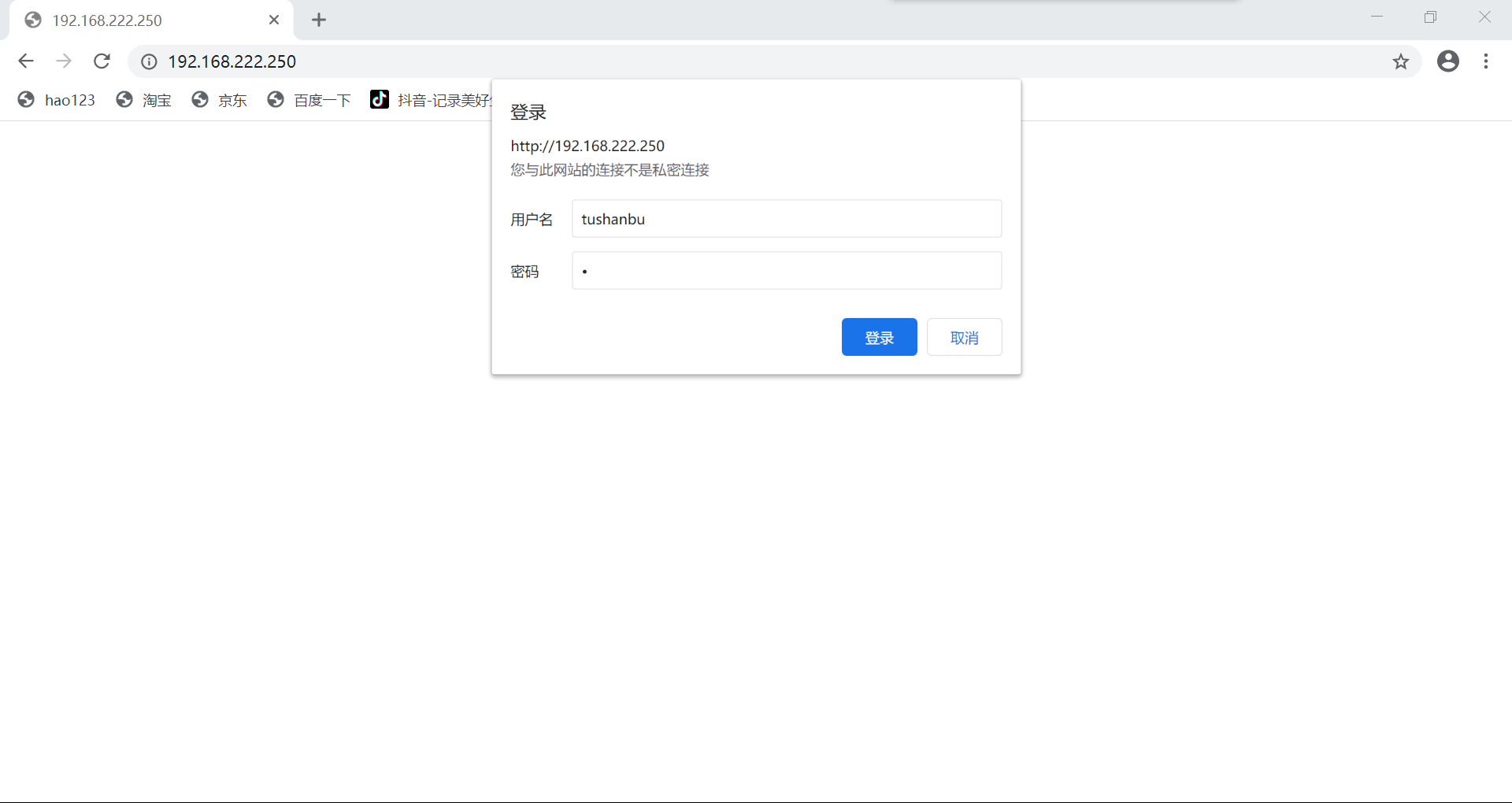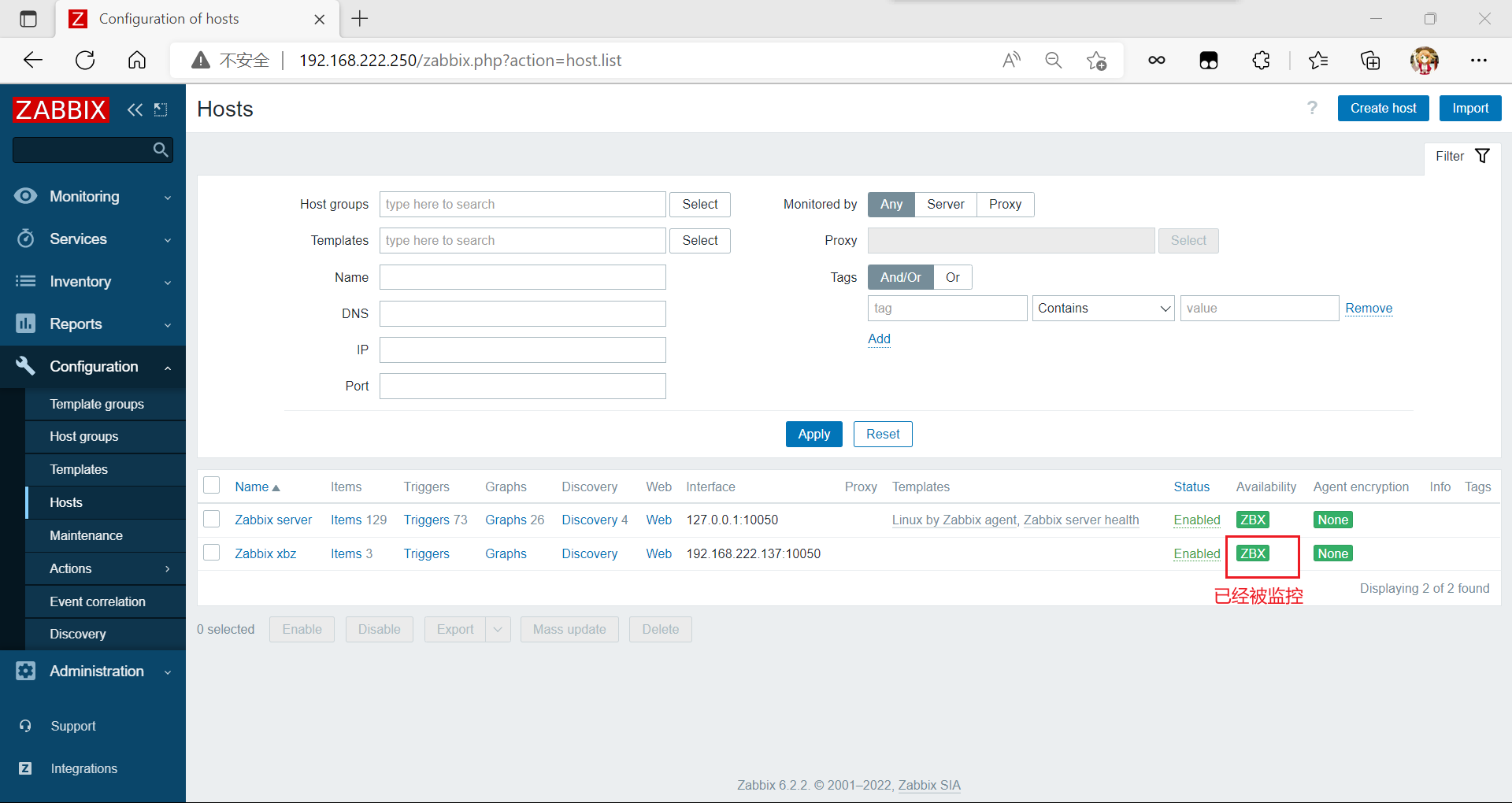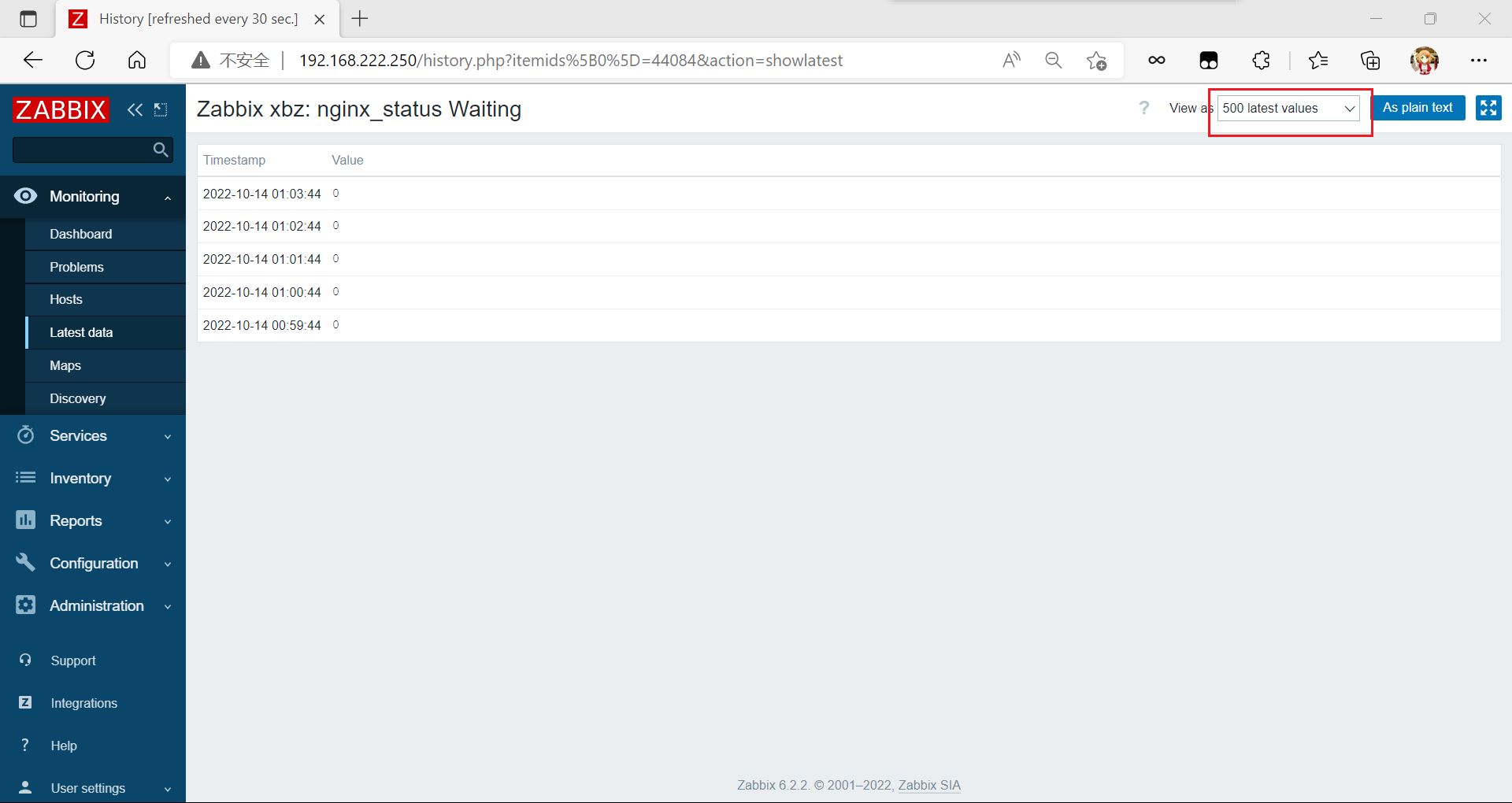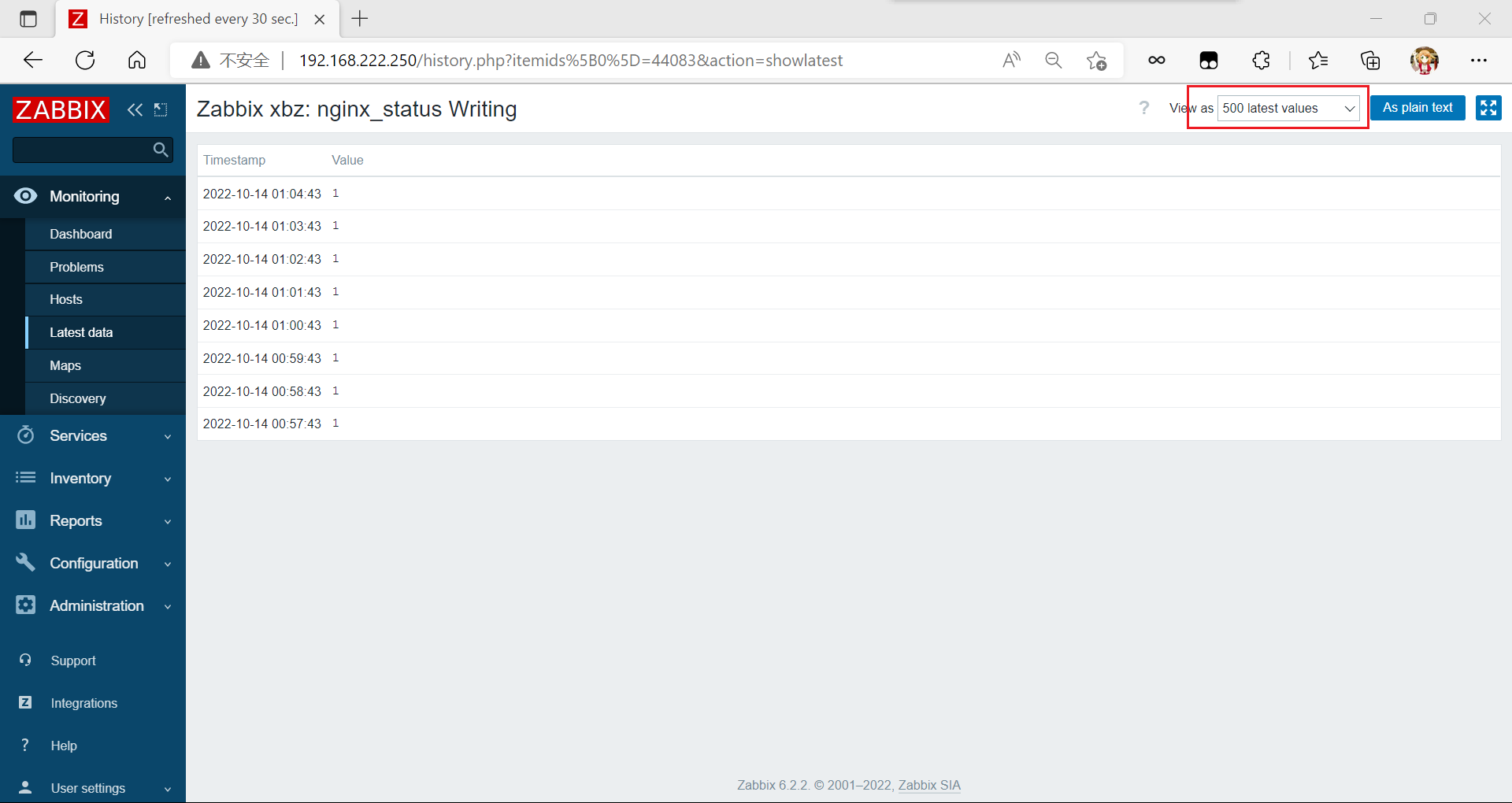nginx
nginx
nginx简介
nginx(发音同engine x)是一款轻量级的Web服务器/反向代理服务器及电子邮件(IMAP/POP3)代理服务器,并在一个BSD-like协议下发行。
nginx由俄罗斯的程序设计师Igor Sysoev所开发,最初供俄国大型的入口网站及搜寻引擎Rambler使用。
第一个公开版本0.1.0发布于2004年10月4日。其将源代码以类BSD许可证的形式发布,因它的稳定性、丰富的功能集、示例配置文件和低系统资源的消耗而闻名。2011年6月1日,nginx 1.0.4发布。
nginx的特点是占有内存少,并发能力强,事实上nginx的并发能力确实在同类型的网页服务器中表现较好,中国大陆使用nginx网站用户有:百度、京东、新浪、网易、腾讯、淘宝等。
nginx的特性与优点
特性
nginx是一个很牛的高性能Web和反向代理服务器,它具有很多非常优越的特性:
在高连接并发的情况下,nginx是Apache服务器不错的替代品,能够支持高达50000个并发连接数的响应
使用epoll and kqueue作为开发模型
nginx作为负载均衡服务器:nginx既可在内部直接支持和PHP程序对外进行服务,也可支持作为HTTP代理服务器对外进行服务
nginx采用C进行编写,不论系统资源开销还是CPU使用效率都比Perlbal要好很多
优点
高并发连接:官方测试能够支撑5万并发连接,在实际生产环境中跑到2-3万并发连接数
内存消耗少:在3万并发连接下,开启的10个nginx进程才消耗150M内存(15M*10=150M)
配置文件非常简单:风格跟程序一样通俗易懂
成本低廉:nginx为开源软件,可以免费使用。而购买F5 BIG-IP、NetScaler等硬件负载均衡交换机则需要十多万至几十万人民币
支持Rewrite重写规则:能够根据域名、URL的不同,将HTTP请求分到不同的后端服务器群组
访问这个http://www.baidu.com/
会变成这个https://www.baidu.com/
内置的健康检查功能:如果Nginx Proxy后端的某台Web服务器宕机了,不会影响前端访问
节省带宽:支持GZIP压缩,可以添加浏览器本地缓存的Header头,在网络上传输时,自动压缩,到了对面自动解压
稳定性高:用于反向代理,宕机的概率微乎其微
模块化设计:模块可以动态编译
动态编译:编译时只编译主程序,其他的额外功能编译成模块,使用的时去加载,主程序比较小
静态编译:在一开始编译将所有的功能编译到主程序中,主程序文件比较大
外围支持好:文档全,二次开发和模块较多
支持热部署:可以不停机重载配置文件,配置文件修改之后让它生效,不需要重启服务
支持事件驱动、AIO(AsyncIO,异步IO)、mmap(Memory Map,内存映射)等性能优化
同步,可以理解为在执行完一个函数或方法之后,一直等待系统返回值或消息,这时程序是出于阻塞的,只有接收到返回的值或消息后才往下执行其他的命令,同步,就是实时处理(如打电话)
同步在一定程度上可以看做是单线程,这个线程请求一个方法后就待这个方法给他回复,否则他不往下执行
异步,执行完函数或方法后,不必阻塞性地等待返回值或消息,只需要向系统委托一个异步过程,那么当系统接收到返回值或消息时,系统会自动触发委托的异步过程,从而完成一个完整的流程。异步,就是分时处理(如收发短信)
异步在一定程度上可以看做是多线程的,请求一个方法后,就不管了,继续执行其他的方法
内存映射:有一份数据在内存中放着,有多个位置需要使用,没有内存映射,同一份数据要生成多份,有的话,可以指向数据存放位置中
正向代理为客户端服务
正向代理
正向代理时,由客户端发送对某一个目标服务器的请求,代理服务器在中间将请求转发给该目标服务器,目标服务器将结果返回给代理服务器,代理服务器再将结果返回给客户端。
使用正向代理时,客户端是需要配置代理服务的地址、端口、账号密码(如有)等才可使用的。
①租客(用户)、②中介(代理服务器)、③房东(国外网站,目标服务器)
租房子一般会很难找到房东(目标服务器),但是房东却会把房屋信息、钥匙给中介(代理服务器)。对于房东(目标服务器)来说,他可能不知道要租他房子的人(用户)是谁,他只知道中介(代理服务器)在联系他。
引入中介(代理服务器)其实也就是因为租客(用户)无法直接联系房东(目标服务器)
反向代理为服务器端服务
反向代理,nginx,负载均衡
服务器根据客户端的请求,从其关系的一组或多组后端服务器(如Web服务器)上获取资源,然后再将这些资源返回给客户端,客户端只会得知代理服务器的IP地址,而不知道在代理服务器后面的服务器集群的存在。
反向代理整个流程:由客户端发起对代理服务器的请求,代理服务器在中间将请求转发给某一个服务器,服务器将结果返回给代理服务器,代理服务器再将结果返回给客户端。
还是租房子:假如没有中介:只有①房东、②二房东(放房东对外租房)、③租客,Web开发中就经常有这种反向代理:客户端(租客)发送请求到负载均衡服务器(二房东),负载均衡服务器(二房东)再把请求转发给一台真正的服务器(房东)来执行,再把执行结果返回给客户端(租客)
透明代理
透明代理也叫做内网代理(inline proxy)、拦截代理(intercepting proxy)以及强制代理(force proxy),所谓透明,即代理对客户端具有无感知性,即不需要客户端进行额外配置。
透明代理和正向代理基本相似,甚至是透明代理可以作为正向代理的一种。
透明代理技术经常作为一种备选模式存在,如在防火墙中作为策略,对部分流量进行过滤拦截;一般公司内的上网行为管理系统也是透明代理的应用。
nginx的扩展功能
基于名称和IP的虚拟主机
支持keepalive
支持平滑升级
定制访问日志、支持使用日志缓冲区提高日志存储性能
支持URL重写
支持路径别名
支持基于IP及用户的访问控制
支持速率限制,支持并发数限制
nginx的应用类别
使用nginx结合FastCGI运行PHP、JSP、Perl等程序
使用nginx作反向代理、负载均衡、规则过滤
使用nginx运行静态HTML网页、图片
nginx与其他新技术的结合应用
nginx的模块分类
nginx的模块从结构上分为核心模块、基础模块和第三方模块
HTTP模块、EVENT模块和MAIL模块等属于核心模块
HTTP Access模块、HTTP FastCGI模块、HTTP Proxy模块和HTTP Rewrite模块属于基本模块
HTTP Upstream模块、Request Hash模块、Notice模块和HTTP Access Key模块属于第三方模块
用户根据自己的需要开发的模块都属于第三方模块。正是有了如此多模块的支撑,nginx的功能才会如此强大
nginx模块从功能上分为三类,分别是:
Handlers(处理器模块)。此类模块直接处理请求,并进行输出内容和修改headers信息等操作。handlers处理器模块一般只能有一个
Filters(过滤器模块)。此类模块主要对其他处理器模块输出的内容进行修改操作,最后由nginx输出
Proxies(代理器模块)。就是nginx的HTTP Upstream之类的模块,这些模块主要与后端一些服务比如fastcgi等操作交互,实现服务代理和负载均衡等功能
nginx模块分为:核心模块、事件模块、标准Http模块、可选Http模块、邮件模块、第三方模块和补丁等
nginx基本模块:所谓基本模块,指的是nginx默认的功能模块,它们提供的指令,允许你使用定义nginx基本功能的变量,在编译时不能被禁用,包括:
核心模块:基本功能和指令,如进程管理和安全。常见的核心模块指令,大部分是放置在配置文件的顶部
事件模块:在Nginx内配置网络使用的能力。常见的events(事件)模块指令,大部分是放置在配置文件的顶部
配置模块:提供包含机制
具体的指令,请参考nginx的官方文档
nginx的工作原理
nginx的模块直接被编译进nginx,因此属于静态编译方式。
启动nginx后,nginx的模块被自动加载,与Apache不一样,首先将模块编译为一个so文件,然后在配置文件中指定是否进行加载。
在解析配置文件时,nginx的每个模块都有可能去处理某个请求,但是同一个处理请求只能由一个模块来完成。
nginx的进程架构:
启动nginx时,会启动一个Master进程,这个进程不处理任何客户端的请求,主要用来产生worker线程,一个worker线程用来处理n个request。

用户先找到nginx,nginx交给master,master生成很多worker,worker包括很多模块,核心功能
worker查看信息是本地处理还是其他人处理。如果是本地处理直接找到硬盘缓存下来处理,下次再请求静态资源直接将缓存资源给他
如果是动态的就通过fastcgi交给应用服务器,应用服务器处理完返还给他
本地缓存没有mencache强大,所以放入mencache中,如果有请求,直接查看mencache缓存
mencache没有持久化
中间的master和proxy是nginx,前端,做负载均衡,worker首先查看资源是动态的还是静态的,是静态的用http交给web server直接处理,处理完成后
webserver 后端做rs
工作方式
在工作方式上,Nginx分为单工作进程和多工作进程两种模式。在单工作进程模式下,除主进程外,还有一个工作进程,工作进程是单线程的;在多工作进程模式下,每个工作进程包含多个线程。Nginx默认为单工作进程模式。
Nginx在启动后,会有一个master进程和多个worker进程。
下图展示了nginx模块一次常规的HTTP请求和响应的过程

用户通过http发出请求,nginx内核建立一个handlers处理器模块,用模块处理,处理完之后,用过滤器进行过滤,得到结果响应用户
处理器模块还会用到代理模块
下图展示了基本的WEB服务请求步骤

通过用户的浏览器跟服务器的nginx建立连接,建立连接用的是tcp/ip协议
建立连接通道之后可以发送请求,nginx收到请求,处理请求,访问资源(资源存放在硬盘上),取出资源之后构建响应,发送响应,然后将所有的事件记录下来(日志)
源码安装nginx
nginx官网
在官网里面找Stable version(稳定版本)
此处我安装的nginx-1.20.2
[root@localhost ~]# systemctl stop firewalld.service //关闭防火墙
[root@localhost ~]# sed -ri 's/^(SELINUX=).*/\1disabled/g' /etc/selinux/config
[root@localhost ~]# setenforce 0
[root@localhost ~]# systemctl disable --now firewalld.service
Removed /etc/systemd/system/multi-user.target.wants/firewalld.service.
Removed /etc/systemd/system/dbus-org.fedoraproject.FirewallD1.service.
[root@localhost ~]# useradd -r -M -s /sbin/nologin nginx
//创建系统用户nginx
[root@localhost ~]# dnf -y install pcre-devel openssl openssl-devel gd-devel gcc gcc-c++ wget make
//安装依赖包
[root@localhost ~]# mkdir -p /var/log/nginx
[root@localhost ~]# chown -R nginx.nginx /var/log/nginx
//创建日志存放目录
[root@localhost ~]# cd /usr/src/
[root@localhost src]# wget http://nginx.org/download/nginx-1.20.2.tar.gz //下载nginx
[root@localhost src]# ls
debug kernels nginx-1.20.2.tar.gz
[root@localhost src]# tar xf nginx-1.20.2.tar.gz
[root@localhost src]# cd nginx-1.20.2/
[root@localhost nginx-1.20.2]# ./configure \ //进行编译
--prefix=/usr/local/nginx \
--user=nginx \
--group=nginx \
--with-debug \
--with-http_ssl_module \
--with-http_realip_module \
--with-http_image_filter_module \
--with-http_gunzip_module \
--with-http_gzip_static_module \
--with-http_stub_status_module \
--http-log-path=/var/log/nginx/access.log \
--error-log-path=/var/log/nginx/error.log
[root@localhost nginx-1.20.2]# make -j $(grep 'processor' /proc/cpuinfo | wc -l)
//统计系统里面有几个cpu。然后进行安装
[root@localhost nginx-1.20.2]# ls
CHANGES CHANGES.ru LICENSE Makefile README auto conf configure contrib html man objs src
[root@localhost nginx-1.20.2]# ls objs/ //编译存放的地方
Makefile nginx ngx_auto_config.h ngx_modules.c src
autoconf.err nginx.8 ngx_auto_headers.h ngx_modules.o
[root@localhost nginx-1.20.2]# file objs/nginx
objs/nginx: ELF 64-bit LSB executable, x86-64, version 1 (SYSV), dynamically linked, interpreter /lib64/ld-linux-x86-64.so.2, for GNU/Linux 3.2.0, BuildID[sha1]=78fd7100a678e28a8c2fa27612bca3c7e6411f9a, with debug_info, not stripped
//ELF主程序文件
[root@localhost nginx-1.20.2]# make install
//安装
[root@localhost nginx-1.20.2]# cd /usr/local/nginx/
[root@localhost nginx]# ls
conf html logs sbin
[root@localhost nginx]# /usr/local/nginx/sbin/nginx //开启ngix
[root@localhost nginx]# ss -antl //查看80端口
State Recv-Q Send-Q Local Address:Port Peer Address:Port Process
LISTEN 0 128 0.0.0.0:80 0.0.0.0:*
LISTEN 0 128 0.0.0.0:22 0.0.0.0:*
LISTEN 0 128 [::]:22 [::]:*
[root@localhost nginx]# echo 'export PATH=/usr/local/nginx/sbin:$PATH' > /etc/profile.d/nginx.sh
//配置环境变量
[root@localhost nginx]# source /etc/profile.d/nginx.sh
//使其生效
[root@localhost nginx]# cd
[root@localhost ~]# which nginx //现在就是可以直接用nginx启动服务
/usr/local/nginx/sbin/nginx
[root@localhost ~]# nginx -s stop //停止服务
[root@localhost ~]# ss -antl
State Recv-Q Send-Q Local Address:Port Peer Address:Port Process
LISTEN 0 128 0.0.0.0:22 0.0.0.0:*
LISTEN 0 128 [::]:22 [::]:*
[root@localhost ~]# nginx //开启服务
[root@localhost ~]# ss -antl
State Recv-Q Send-Q Local Address:Port Peer Address:Port Process
LISTEN 0 128 0.0.0.0:80 0.0.0.0:*
LISTEN 0 128 0.0.0.0:22 0.0.0.0:*
LISTEN 0 128 [::]:22 [::]:*
//服务控制方式,使用nginx命令
-t //检查配置文件语法
-v //输出nginx的版本
-c //指定配置文件的路径
-s //发送服务控制信号,可选值有{stop|quit|reopen|reload}
访问:

将其添加到systemd服务里面
[root@localhost ~]# cp /usr/lib/systemd/system/sshd.service /usr/lib/systemd/system/nginx.service
[root@localhost ~]# vim /usr/lib/systemd/system/nginx.service
[root@localhost ~]# cat /usr/lib/systemd/system/nginx.service
[Unit]
Description=nginx server daemon
After=network.target
[Service]
Type=forking
ExecStart=/usr/local/nginx/sbin/nginx
ExecStop=/usr/local/nginx/sbin/nginx -s stop
ExecReload=/bin/kill -HUP $MAINPID
[Install]
WantedBy=multi-user.target
[root@localhost ~]# nginx -s stop //先停止nginx
[root@localhost ~]# systemctl daemon-reload
//加载配置
[root@localhost ~]# systemctl enable --now nginx.service //设置开机自启
Created symlink /etc/systemd/system/multi-user.target.wants/nginx.service → /usr/lib/systemd/system/nginx.service.
[root@localhost ~]# systemctl enable --now nginx.service
Created symlink /etc/systemd/system/multi-user.target.wants/nginx.service → /usr/lib/systemd/system/nginx.service.
[root@localhost ~]# systemctl status nginx.service //查看状态
● nginx.service - nginx server daemon
Loaded: loaded (/usr/lib/systemd/system/nginx.service; enabled; vendor preset: disabled)
Active: active (running) since Wed 2022-10-12 21:16:18 CST; 47s ago
Process: 76036 ExecStart=/usr/local/nginx/sbin/nginx (code=exited, status=0/SUCCESS)
Main PID: 76037 (nginx)
Tasks: 2 (limit: 12221)
Memory: 2.5M
CGroup: /system.slice/nginx.service
├─76037 nginx: master process /usr/local/nginx/sbin/nginx
└─76038 nginx: worker process
Oct 12 21:16:18 localhost systemd[1]: Starting nginx server daemon...
Oct 12 21:16:18 localhost systemd[1]: Started nginx server daemon.
[root@localhost ~]# ss -antl //查看端口
State Recv-Q Send-Q Local Address:Port Peer Address:Port Process
LISTEN 0 128 0.0.0.0:80 0.0.0.0:*
LISTEN 0 128 0.0.0.0:22 0.0.0.0:*
LISTEN 0 128 [::]:22 [::]:*
访问:

nginx平滑升级
平滑升级流程
获取老版本的编译信息
获取新版本安装包或者功能包
配置新版本或功能,配置时加上老版本的编译信息和新版本或功能
编译,编译后不执行安装操作
备份老版本程序
停止老版本程序或进程
将新版本复制到老版本所在位置替换老版本
启动新版本
//此处接着前面的源码安装nginx进行操作
[root@localhost ~]# nginx -V //查看版本信息(此时是老版本)
nginx version: nginx/1.20.2
built by gcc 8.5.0 20210514 (Red Hat 8.5.0-4) (GCC)
built with OpenSSL 1.1.1k FIPS 25 Mar 2021
TLS SNI support enabled
configure arguments: --prefix=/usr/local/nginx --user=nginx --group=nginx --with-debug --with-http_ssl_module --with-http_realip_module --with-http_image_filter_module --with-http_gunzip_module --with-http_gzip_static_module --with-http_stub_status_module --http-log-path=/var/log/nginx/access.log --error-log-path=/var/log/nginx/error.log
[root@localhost ~]# dnf -y install git //获取新版本安装包和功能包(功能包可以git克隆)
[root@localhost ~]# cd /usr/local/src/
[root@localhost src]# wget https://nginx.org/download/nginx-1.22.0.tar.gz //下载新版本的包
[root@localhost src]# git clone https://gitee.com/wujunze/nginx_module_echo.git
Cloning into 'nginx_module_echo'...
remote: Enumerating objects: 80, done.
remote: Total 80 (delta 0), reused 0 (delta 0), pack-reused 80
Unpacking objects: 100% (80/80), 14.32 KiB | 666.00 KiB/s, done.
[root@localhost src]# ls
nginx-1.22.0.tar.gz nginx_module_echo
[root@localhost src]# tar -xf nginx-1.22.0.tar.gz
[root@localhost src]# cd nginx-1.22.0/
[root@localhost nginx-1.22.0]# ./configure \ //配置时,老版本的配置加上新加的模块,用--add-module=模块目录参数
> --prefix=/usr/local/nginx \
> --user=nginx \
> --group=nginx \
> --with-debug \
> --with-http_ssl_module \
> --with-http_realip_module \
> --with-http_image_filter_module \
> --with-http_gunzip_module \
> --with-http_gzip_static_module \
> --with-http_stub_status_module \
> --add-module=../nginx_module_echo
[root@localhost nginx-1.22.0]# make -j $(grep 'processor' /proc/cpuinfo | wc -l) //开始安装,此时不要先安装
[root@localhost nginx-1.22.0]# objs/nginx -v
nginx version: nginx/1.22.0
[root@localhost nginx-1.22.0]# \cp /usr/local/nginx/sbin/nginx{,-bak};pkill nginx;\cp objs/nginx /usr/local/nginx/sbin/;systemctl start nginx //替换版本,使用一条命令解决
[root@localhost nginx-1.22.0]# nginx -v //此时已经替换为新版本,服务也启动了
nginx version: nginx/1.22.0
[root@localhost nginx-1.22.0]# ss -antl //查看端口
State Recv-Q Send-Q Local Address:Port Peer Address:Port Process
LISTEN 0 128 0.0.0.0:80 0.0.0.0:*
LISTEN 0 128 0.0.0.0:22 0.0.0.0:*
LISTEN 0 128 [::]:22 [::]:*
访问:

nginx配置文件
主配置文件:/usr/local/nginx/conf/nginx.conf
默认启动nginx时,使用的配置文件是:安装路径/conf/nginx.conf文件
可以在启动nginx时通过-c选项来指定要读取的配置文件
nginx常见的配置文件及其作用
| 配置文件 | 作用 |
|---|---|
| nginx.conf | nginx的基本配置文件 |
| mime.types | MIME类型关联的扩展文件 |
| fastcgi.conf | 与fastcgi相关的配置 |
| proxy.conf | 与proxy相关的配置 |
| sites.conf | 配置nginx提供的网站,包括虚拟主机 |
[root@localhost nginx]# pwd
/usr/local/nginx
[root@localhost nginx]# ls
client_body_temp conf fastcgi_temp html logs proxy_temp sbin scgi_temp uwsgi_temp
[root@localhost nginx]# ls logs/
nginx.pid
[root@localhost nginx]# ls sbin/nginx //主程序
sbin/nginx
[root@localhost nginx]# file sbin/nginx //ELF(主程序)
sbin/nginx: ELF 64-bit LSB executable, x86-64, version 1 (SYSV), dynamically linked, interpreter /lib64/ld-linux-x86-64.so.2, for GNU/Linux 3.2.0, BuildID[sha1]=146c123f448d84a21258affd355418734db34b42, with debug_info, not stripped
[root@localhost nginx]# ls html/ //网站
50x.html index.html
[root@localhost nginx]# cd conf/ //主配置文件
[root@localhost conf]# ls
fastcgi.conf koi-utf nginx.conf uwsgi_params
fastcgi.conf.default koi-win nginx.conf.default uwsgi_params.default
fastcgi_params mime.types scgi_params win-utf
fastcgi_params.default mime.types.default scgi_params.default
[root@localhost conf]# ls nginx.conf
nginx.conf
查看帮助以及nginx的参数
[root@localhost ~]# nginx -h
nginx version: nginx/1.22.0
Usage: nginx [-?hvVtTq] [-s signal] [-p prefix]
[-e filename] [-c filename] [-g directives]
Options:
-?,-h : this help
-v : show version and exit
-V : show version and configure options then exit
-t : test configuration and exit
-T : test configuration, dump it and exit
-q : suppress non-error messages during configuration testing
-s signal : send signal to a master process: stop, quit, reopen, reload
-p prefix : set prefix path (default: /usr/local/nginx/)
-e filename : set error log file (default: logs/error.log)
-c filename : set configuration file (default: conf/nginx.conf)
-g directives : set global directives out of configuration file
[root@localhost ~]# nginx -v //查看版本
nginx version: nginx/1.22.0
[root@localhost ~]# nginx -V //显示版本并配置选项,显示编译时的文件
nginx version: nginx/1.22.0
built by gcc 8.5.0 20210514 (Red Hat 8.5.0-4) (GCC)
built with OpenSSL 1.1.1k FIPS 25 Mar 2021
TLS SNI support enabled
configure arguments: --prefix=/usr/local/nginx --user=nginx --group=nginx --with-debug --with-http_ssl_module --with-http_realip_module --with-http_image_filter_module --with-http_gunzip_module --with-http_gzip_static_module --with-http_stub_status_module --add-module=../nginx_module_echo
选项:
-h:这个帮助
-v:显示版本并退出
-V:显示版本并配置选项,然后退出
-t:测试配置并退出
-T:测试配置,下载并退出
-q:在配置测试时抑制非错误消息
向主进程发送信号:停止,退出,重新打开,重新加载
设置前缀路径(默认为/usr/local/nginx/)
-e filename:设置错误日志文件(默认为/var/log/nginx/error.log)
-c filename:设置配置文件(默认为conf/nginx.conf),将配置文件copy一份,修改新的配置文件,使用-c指定配置文件
-g directives:将全局指令从配置文件中设置出来
查看日志
[root@localhost ~]# cd /usr/local/nginx/
[root@localhost nginx]# tail -4 /var/log/nginx/access.log
192.168.222.1 - - [10/Oct/2022:21:26:01 +0800] "GET / HTTP/1.1" 200 615 "-" "Mozilla/5.0 (Windows NT 10.0; Win64; x64) AppleWebKit/537.36 (KHTML, like Gecko) Chrome/106.0.0.0 Safari/537.36 Edg/106.0.1370.37"
192.168.222.1 - - [10/Oct/2022:21:26:01 +0800] "GET /favicon.ico HTTP/1.1" 404 555 "http://192.168.222.250/" "Mozilla/5.0 (Windows NT 10.0; Win64; x64) AppleWebKit/537.36 (KHTML, like Gecko) Chrome/106.0.0.0 Safari/537.36 Edg/106.0.1370.37"
192.168.222.1 - - [10/Oct/2022:21:52:36 +0800] "GET / HTTP/1.1" 304 0 "-" "Mozilla/5.0 (Windows NT 10.0; Win64; x64) AppleWebKit/537.36 (KHTML, like Gecko) Chrome/106.0.0.0 Safari/537.36 Edg/106.0.1370.37"
[root@localhost nginx]# tail -1f /var/log/nginx/access.log
192.168.222.1 - - [10/Oct/2022:21:52:36 +0800] "GET / HTTP/1.1" 304 0 "-" "Mozilla/5.0 (Windows NT 10.0; Win64; x64) AppleWebKit/537.36 (KHTML, like Gecko) Chrome/106.0.0.0 Safari/537.36 Edg/106.0.1370.37"
//f一直查看
nginx.conf配置详解
nginx.conf的内容分为以下几段:
main配置段:全局配置段。其中main配置段中可能包含event配置段
event {}:定义event模型工作特性
http {}:定义http协议相关的配置
配置指令:要以分号结尾,语法格式如下:
derective value1 [value2 ...];
支持使用变量:
内置变量:模块会提供内建变量定义
自定义变量:set var_name value
用于调试、定位问题的配置参数
daemon {on|off}; //是否以守护进程方式运行nginx,调试时应设置为off
master_process {on|off}; //是否以master/worker模型来运行nginx,调试时可以设置为off
error_log 位置 级别; //配置错误日志
error_log里的位置和级别能有以下可选项:
| 位置 | 级别 |
|---|---|
| file stderr syslog:server=address[,parameter=value] memory:size |
debug:若要使用debug级别,需要在编译nginx时使用–with-debug选项 info notice warn error crit alert emer |
正常运行必备的配置参数
user USERNAME [GROUPNAME]; //指定运行worker进程的用户和组
pid /path/to/pid_file; //指定nginx守护进程的pid文件
worker_rlimit_nofile number; //设置所有worker进程最大可以打开的文件数,默认为1024
worker_rlimit_core size; //指明所有worker进程所能够使用的总体的最大核心文件大小,保持默认即可
优化性能的配置参数
worker_processes n; //启动n个worker进程,这里的n为了避免上下文切换,通常设置为cpu总核心数-1或等于总核心数
worker_cpu_affinity cpumask ...; //将进程绑定到某cpu中,避免频繁刷新缓存
//cpumask:使用8位二进制表示cpu核心,如:
0000 0001 //第一颗cpu核心
0000 0010 //第二颗cpu核心
0000 0100 //第三颗cpu核心
0000 1000 //第四颗cpu核心
0001 0000 //第五颗cpu核心
0010 0000 //第六颗cpu核心
0100 0000 //第七颗cpu核心
1000 0000 //第八颗cpu核心
timer_resolution interval; //计时器解析度。降低此值,可减少gettimeofday()系统调用的次数
worker_priority number; //指明worker进程的nice值
6.5 事件相关的配置:event{}段中的配置参数
accept_mutex {off|on}; //master调度用户请求至各worker进程时使用的负载均衡锁;on表示能让多个worker轮流地、序列化地去响应新请求
lock_file file; //accept_mutex用到的互斥锁锁文件路径
use [epoll | rtsig | select | poll]; //指明使用的事件模型,建议让nginx自行选择
worker_connections #; //每个进程能够接受的最大连接数
网络连接相关的配置参数
keepalive_timeout number; //长连接的超时时长,默认为65s
keepalive_requests number; //在一个长连接上所能够允许请求的最大资源数
keepalive_disable [msie6|safari|none]; //为指定类型的UserAgent禁用长连接
tcp_nodelay on|off; //是否对长连接使用TCP_NODELAY选项,为了提升用户体验,通常设为on
client_header_timeout number; //读取http请求报文首部的超时时长
client_body_timeout number; //读取http请求报文body部分的超时时长
send_timeout number; //发送响应报文的超时时长
fastcgi的相关配置参数
LNMP:php要启用fpm模型
配置示例如下:
location ~ \.php$ {
root html;
fastcgi_pass 127.0.0.1:9000; //定义反向代理
fastcgi_index index.php;
fastcgi_param SCRIPT_FILENAME /scripts$fastcgi_script_name;
include fastcgi_params;
}
nginx作为web服务器时使用的配置:http{}段的配置参数
http{…}:配置http相关,由ngx_http_core_module模块引入。nginx的HTTP配置主要包括四个区块,结构如下:
http {//协议级别
include mime.types;
default_type application/octet-stream;
keepalive_timeout 65;
gzip on;
upstream { //负载均衡配置
...
}
server { //服务器级别,每个server类似于httpd中的一个<VirtualHost>
listen 80;
server_name localhost;
location / { //请求级别,类似于httpd中的<Location>,用于定义URL与本地文件系统的映射关系
root html;
index index.html index.htm;
}
}
}
http{}段配置指令
server {}:定义一个虚拟主机,示例如下:
server {
listen 80;
server_name www.idfsoft.com;
root "/vhosts/web";
}
listen:指定监听的地址和端口
listen address[:port];
listen port;
server_name NAME [...]; 后面可跟多个主机,名称可使用正则表达式或通配符
当有多个server时,匹配顺序如下:
- 先做精确匹配检查
- 左侧通配符匹配检查,如*.idfsoft.com
- 右侧通配符匹配检查,如mail.*
- 正则表达式匹配检查,如~ ^.*.idfsoft.com$
- default_server
root path; 设置资源路径映射,用于指明请求的URL所对应的资源所在的文件系统上的起始路径
alias path; 用于location配置段,定义路径别名
index file; 默认主页面
index index.php index.html;
error_page code […] [=code] URI | @name 根据http响应状态码来指明特用的错误页面,例如 error_page 404 /404_customed.html
[=code]:以指定的响应码进行响应,而不是默认的原来的响应,默认表示以新资源的响应码为其响应码,例如 error_page 404 =200 /404_customed.html
log_format 定义日志格式
log_format main '$remote_addr - $remote_user [$time_local] "$request" '
'$status $body_bytes_sent "$http_referer" '
'"$http_user_agent" "$http_x_forwarded_for"';
access_log logs/access.log main;
//注意:格式名main可自己定义,但要一一对应,另外此处可用变量为nginx各模块内建变量
location区段,通过指定模式来与客户端请求的URI相匹配
//功能:允许根据用户请求的URI来匹配定义的各location,匹配到时,此请求将被相应的location配置块中的配置所处理,例如做访问控制等功能
//语法:location [ 修饰符 ] pattern {......}
常用修饰符说明:
| 修饰符 | 功能 |
|---|---|
| = | 精确匹配 |
| ~ | 正则表达式模式匹配,区分大小写 |
| ~* | 正则表达式模式匹配,不区分大小写 |
| ^~ | 前缀匹配,类似于无修饰符的行为,也是以指定模块开始,不同的是,如果模式匹配,那么就停止搜索其他模式了,不支持正则表达式 |
| @ | 定义命名location区段,这些区段客户端不能访问,只可以由内部产生的请求来访问,如try_files或error_page等 |
查找顺序和优先级:由高到底依次为
- 带有=的精确匹配优先
- 带有^~修饰符的,开头匹配
- 正则表达式按照他们在配置文件中定义的顺序
- 带有或*修饰符的,如果正则表达式与URI匹配
- 没有修饰符的精确匹配
优先级如下:
( location = 路径 ) --> ( location ^~ 路径 ) --> ( location ~ 正则 ) --> ( location ~* 正则 ) --> ( location 路径 )
没添加任何修饰符则按先后顺序
[root@localhost ~]# vim /usr/local/nginx/conf/nginx.conf
server {
listen 80;
server_name localhost; //在这个下面添加下面配置
location / {
echo 'tushanbu';
}
location /xbz {
echo 'xbz';
}
location /tsb {
echo 'tsb';
}
注释下面的
location / {
root html;
index index.html index.htm;
}
[root@localhost ~]# systemctl reload nginx.service
//重新加载配置
[root@localhost ~]# curl 192.168.222.250
tushanbu
[root@localhost ~]# curl 192.168.222.250/xbz
xbz
[root@localhost ~]# curl 192.168.222.250/tsb
tsb
=精确匹配
[root@localhost ~]# vim /usr/local/nginx/conf/nginx.conf
server {
listen 80;
server_name localhost;
location / {
echo 'tushanbu';
}
location /tsb { //修改
echo 'xbz';
}
location = /tsb { //修改
echo 'tsb';
}
[root@localhost ~]# systemctl reload nginx.service
//重新加载配置
[root@localhost ~]# curl 192.168.222.250/tsb
tsb
//可看见相同的目录,等于号的级别大
添加 ~ 为区分大小写
[root@localhost ~]# vim /usr/local/nginx/conf/nginx.conf
server {
listen 80;
server_name localhost;
location / {
echo 'tushanbu';
}
location /tsb {
echo 'xbz';
}
location ~ /tsb { //修改
echo 'tsb';
}
[root@localhost ~]# systemctl reload nginx.service
//重新加载配置
[root@localhost ~]# curl 192.168.222.250/TSB
tushanbu //因为区分大小写找不到资源所以输出的是默认tushanbu
[root@localhost ~]# curl 192.168.222.250/tsb
tsb
~ 为不区分大小写*
[root@localhost ~]# vim /usr/local/nginx/conf/nginx.conf
server {
listen 80;
server_name localhost;
location / {
echo 'tushanbu';
}
location /tsb {
echo 'xbz';
}
location ~* /tsb { //修改
echo 'tsb';
}
[root@localhost ~]# systemctl reload nginx.service
//重新加载配置
[root@localhost ~]# curl 192.168.222.250/TSB
tsb
[root@localhost ~]# curl 192.168.222.250/tsb
tsb
//因为不区分大小写所以TSB和tsb都能访问到tsb
^~ 为前缀匹配
server {
listen 80;
server_name localhost;
location / {
echo 'tushanbu';
}
location ^~/tsb { //修改
echo 'xbz';
}
location ~ /tsb { //修改
echo 'tsb';
}
[root@localhost ~]# systemctl reload nginx.service
//重新加载配置
[root@localhost ~]# curl 192.168.222.250/tsb
xbz
//前缀匹配如果访问到了资源则停止搜索
Nginx访问控制
用于http, server, location, limit_except段
allow:设定允许哪台或哪些主机访问
deny:设定禁止哪台或哪些主机访问
[root@localhost html]# cd
[root@localhost ~]# cd /usr/local/nginx/
[root@localhost nginx]# ls
client_body_temp fastcgi_temp proxy_temp scgi_temp
conf html logs sbin uwsgi_temp
[root@localhost html]# ls
50x.html index.html
[root@localhost html]# echo "hello lnh" >index.html //可以向要网站里面编辑内容
[root@localhost html]# systemctl restart nginx.service
//重启服务
[root@localhost html]# ss -antl
State Recv-Q Send-Q Local Address:Port Peer Address:Port Process
LISTEN 0 128 0.0.0.0:80 0.0.0.0:*
LISTEN 0 128 0.0.0.0:22 0.0.0.0:*
LISTEN 0 128 [::]:22 [::]:*
[root@localhost html]# curl 192.168.222.250 //访问
hello lnh
访问:

[root@localhost html]# cd
[root@localhost ~]# vim /usr/local/nginx/conf/nginx.conf
location / {
root html;
index index.html index.htm;
allow 192.168.222.250; //添加(只允许这个ip访问)
deny all; //添加(拒绝其他ip访问)
}
[root@localhost ~]# curl 127.0.0.1 //本机ip在虚拟机里面无法访问
<html>
<head><title>403 Forbidden</title></head>
<body>
<center><h1>403 Forbidden</h1></center>
<hr><center>nginx/1.22.0</center>
</body>
</html>
[root@localhost ~]# curl 192.168.222.250 //允许的ip可以访问
hello lnh
使用本机ip在网页上面访问:

//此时也是无法访问的
nginx用户认证
auth_basic "欢迎信息";
auth_basic_user_file "/path/to/user_auth_file" //密码存放位置
[root@localhost ~]# dnf -y install httpd-tools
//安装httpd工具包
[root@localhost ~]# vim /usr/local/nginx/conf/nginx.conf
location / {
root html;
index index.html index.htm;
auth_basic "hello"; //添加
auth_basic_user_file "/usr/local/nginx/conf/.pass"; //密码存放位置
}
[root@localhost ~]# systemctl daemon-reload
//重新加载一下配置
[root@localhost ~]# cd /usr/local/nginx/conf/
[root@localhost conf]# htpasswd -cm /usr/local/nginx/conf/.pass tushanbu
//生成用户密码
New password: //新密码
Re-type new password: //再次输入
Adding password for user tushanbu
[root@localhost conf]# cat .pass
tushanbu:$apr1$kNKZPdty$rn3EvbmPAL0XYTSWPzSmt1
//加密后的密码
[root@localhost conf]# systemctl restart nginx.service
//重启服务
使用谷歌浏览器进行访问:


https配置
生成私钥,生成证书签署请求并获得证书,然后在nginx.conf中进行配置
证书申请及签署步骤:
- 生成申请请求
- RA核验
- CA签署
- 获取证书
[root@localhost ~]# cd /etc/pki/
[root@localhost pki]# mkdir CA
[root@localhost pki]# cd CA/
[root@localhost CA]# mkdir private
[root@localhost CA]# (umask 077;openssl genrsa -out private/cakey.pem 2048)
Generating RSA private key, 2048 bit long modulus (2 primes)
.........................................................................+++++
...........................................................+++++
e is 65537 (0x010001)
[root@localhost CA]# ls private/
cakey.pem
[root@localhost CA]# openssl req -new -x509 -key private/cakey.pem -out cacert.pem -days 365
You are about to be asked to enter information that will be incorporated
into your certificate request.
What you are about to enter is what is called a Distinguished Name or a DN.
There are quite a few fields but you can leave some blank
For some fields there will be a default value,
If you enter '.', the field will be left blank.
-----
Country Name (2 letter code) [XX]:CN //国家
State or Province Name (full name) []:HB //省份
Locality Name (eg, city) [Default City]:WH //城市
Organization Name (eg, company) [Default Company Ltd]:PX 组织
Organizational Unit Name (eg, section) []:www.example.com //部门
Common Name (eg, your name or your server's hostname) []:www.example.com //域名
Email Address []:136@78.com //邮箱
[root@localhost CA]# mkdir certs newcerts crl
[root@localhost CA]# ls
cacert.pem certs crl newcerts private
[root@localhost CA]# touch index.txt && echo 01 > serial
[root@localhost CA]# cd /usr/local/nginx/conf/
[root@localhost conf]# mkdir ssl
[root@localhost conf]# cd ssl/
[root@localhost ssl]# (umask 077;openssl genrsa -out nginx.key 2048)
//生成密钥
Generating RSA private key, 2048 bit long modulus (2 primes)
..............................................................+++++
......................................+++++
e is 65537 (0x010001)
[root@localhost ssl]# openssl req -new -key nginx.key -days 365 -out nginx.csr
//证书签署请求
Ignoring -days; not generating a certificate
You are about to be asked to enter information that will be incorporated
into your certificate request.
What you are about to enter is what is called a Distinguished Name or a DN.
There are quite a few fields but you can leave some blank
For some fields there will be a default value,
If you enter '.', the field will be left blank.
-----
Country Name (2 letter code) [XX]:CN
State or Province Name (full name) []:HB
Locality Name (eg, city) [Default City]:WH
Organization Name (eg, company) [Default Company Ltd]:PX
Organizational Unit Name (eg, section) []:www.example.com
Common Name (eg, your name or your server's hostname) []:www.example.com
Email Address []:136@78.com
Please enter the following 'extra' attributes
to be sent with your certificate request
A challenge password []:
An optional company name []:
[root@localhost ssl]# openssl ca -in nginx.csr -out nginx.crt -days 365
//签署证书
Using configuration from /etc/pki/tls/openssl.cnf
Check that the request matches the signature
Signature ok
Certificate Details:
Serial Number: 1 (0x1)
Validity
Not Before: Oct 13 14:47:54 2022 GMT
Not After : Oct 13 14:47:54 2023 GMT
Subject:
countryName = CN
stateOrProvinceName = HB
organizationName = PX
organizationalUnitName = www.example.com
commonName = www.example.com
emailAddress = 136@78.com
X509v3 extensions:
X509v3 Basic Constraints:
CA:FALSE
Netscape Comment:
OpenSSL Generated Certificate
X509v3 Subject Key Identifier:
0E:2D:C4:CD:75:04:54:AF:D9:CD:0E:1E:1E:01:13:BE:DB:E8:39:EA
X509v3 Authority Key Identifier:
keyid:84:C1:11:1D:9A:90:0D:AF:2C:EA:FD:10:40:D5:FF:C3:07:7F:FD:D0
Certificate is to be certified until Oct 13 14:47:54 2023 GMT (365 days)
Sign the certificate? [y/n]:y
1 out of 1 certificate requests certified, commit? [y/n]y
Write out database with 1 new entries
Data Base Updated
[root@localhost ssl]# ls
nginx.crt nginx.csr nginx.key
[root@localhost ssl]# cd ..
[root@localhost conf]# vim nginx.conf //修改配置文件加入生成的密钥和证书
//先取消注释再修改
server {
listen 443 ssl;
server_name www.example.com;
ssl_certificate /usr/local/nginx/conf/ssl/nginx.crt; //证书存放的位置
ssl_certificate_key /usr/local/nginx/conf/ssl/nginx.key; //密钥存放的位置
ssl_session_cache shared:SSL:1m;
ssl_session_timeout 5m;
ssl_ciphers HIGH:!aNULL:!MD5;
ssl_prefer_server_ciphers on;
location / {
root html;
index index.html index.htm;
}
}
}
[root@localhost conf]# systemctl restart nginx.service
//重启服务
访问:



Nginx启用状态页面
开启status:stub_status [on | off]; (不添加参数默认on)
应用于server,location段
下载新模块地址
如果没有可以下载到本地,然后上传到nginx服务器
或者安装我前面平滑升级里面的方法来
[root@localhost ~]# nginx -V
nginx version: nginx/1.22.0
built by gcc 8.5.0 20210514 (Red Hat 8.5.0-4) (GCC)
built with OpenSSL 1.1.1k FIPS 25 Mar 2021
TLS SNI support enabled
configure arguments: --prefix=/usr/local/nginx --user=nginx --group=nginx --with-debug --with-http_ssl_module --with-http_realip_module --with-http_image_filter_module --with-http_gunzip_module --with-http_gzip_static_module --with-http_stub_status_module --add-module=../nginx_module_echo
//首先得有--with-http_stub_status_module模块
[root@localhost ~]# vim /usr/local/nginx/conf/nginx.conf //编辑配置文件,开启状态页面
location = /status {
stub_status;
}
[root@localhost ~]# systemctl restart nginx.service
//重启服务
[root@localhost ~]# curl 127.0.0.1/status //查看访问结果
Active connections: 1
server accepts handled requests
1 1 1
Reading: 0 Writing: 1 Waiting: 0
访问:

状态页面信息详解:
| 状态码 | 表示的意义 |
|---|---|
| Active connections |
当前所有处于打开状态的连接数 |
| accepts | 总共处理了多少个连接 |
| handled | 成功创建多少握手 |
| requests | 总共处理了多少个请求 |
| Reading | nginx读取到客户端的Header信息数,表示正处于接收请求状态的连接数 |
| Writing | nginx返回给客户端的Header信息数,表示请求已经接收完成 且正处于处理请求或发送响应的过程中的连接数 |
| Waiting | 开启keep-alive的情况下,这个值等于active - (reading + writing),<>意思就是Nginx已处理完正在等候下一次请求指令的驻留连接 |
zabbix监控Nginx状态
环境说明
| 主机名 | ip | 服务 | 系统 |
|---|---|---|---|
| zabbix | 192.168.222.250 | lamp zabbix-server zabbix-agentd |
centos8 |
| nginx | 192.168.222.137 | nginx zabbix_agentd |
centos8 |
zabbix的安装部署以及一些操作可以看我的博客监控服务zabbix部署,zabbix的基础使用,
zabbix监控详解里面有zabbix部署和lamp的详细操作
nginx还是进行源码安装
nginx端,安装zabbix_agentd
zabbix-6.2源码包
[root@nginx ~]# cd /usr/local/etc/
[root@nginx etc]# useradd -rMs /sbin/nologin zabbix //创建zabbix用户
[root@nginx etc]# cd /usr/src/
[root@nginx src]# wget https://cdn.zabbix.com/zabbix/sources/stable/6.2/zabbix-6.2.2.tar.gz //下载源码包
[root@nginx src]# ls
debug kernels zabbix-6.2.2.tar.gz
[root@nginx src]# tar xf zabbix-6.2.2.tar.gz //解压
[root@nginx src]# cd zabbix-6.2.2/
[root@nginx zabbix-6.2.2]# dnf -y install openssl-devel pcre-devel expat-devel gcc gcc-c++ make //安装依赖包
[root@nginx zabbix-6.2.2]# ./configure --enable-agent
//进行编译
....
***********************************************************
* Now run 'make install' *
* *
* Thank you for using Zabbix! *
* <http://www.zabbix.com> *
***********************************************************
[root@nginx zabbix-6.2.2]# make install //安装
[root@nginx zabbix-6.2.2]# cd /usr/local/etc/
[root@nginx etc]# ls
zabbix_agentd.conf zabbix_agentd.conf.d
[root@nginx etc]# vim zabbix_agentd.conf
//修改配置文件
Server=192.168.222.250 //服务端ip
ServerActive=192.168.222.250 //服务端ip
Hostname=Zabbix xbz //zabbix系统内主机名,可自定义,但要确保唯一性
[root@nginx etc]# ldconfig //刷新配置
[root@nginx etc]# zabbix_agentd //启动zabbix_agentd
[root@nginx etc]# ss -antl //查看端口
State Recv-Q Send-Q Local Address:Port Peer Address:Port Process
LISTEN 0 128 0.0.0.0:22 0.0.0.0:*
LISTEN 0 128 0.0.0.0:10050 0.0.0.0:*
LISTEN 0 128 0.0.0.0:80 0.0.0.0:*
LISTEN 0 128 [::]:22 [::]:*
开启状态页面,并在nginx端写监控脚本
[root@nginx ~]# vim /usr/local/nginx/conf/nginx.conf
....
location = /status {
stub_status;
allow 127.0.0.1; //只允许本地ip访问
deny all; //拒绝其他ip访问
}
[root@nginx ~]# systemctl restart nginx.service
//重启服务
[root@nginx ~]# mkdir /scripts
[root@nginx ~]# cd /scripts/
[root@nginx scripts]# vim nginx_status.sh
[root@nginx scripts]# cat nginx_status.sh
#/bin/bash
case $1 in
Reading)
curl -s 127.0.0.1/status |awk "NR==4{print\$2}"
;;
Writing)
curl -s 127.0.0.1/status |awk "NR==4{print\$4}"
;;
Waiting)
curl -s 127.0.0.1/status |awk "NR==4{print\$6}"
;;
*)
exit
;;
esac
[root@nginx scripts]# chmod +x nginx_status.sh
[root@nginx scripts]# vim /usr/local/etc/zabbix_agentd.conf
UnsafeUserParameters=1 //取消注释并修改
UserParameter=nginx_status[*],/bin/bash /scripts/nginx_status.sh $1 //取消注释并修改
[root@nginx scripts]# pkill zabbix_agentd //关闭
[root@nginx scripts]# zabbix_agentd //开启
[root@nginx scripts]# ss -antl
State Recv-Q Send-Q Local Address:Port Peer Address:Port Process
LISTEN 0 128 0.0.0.0:22 0.0.0.0:*
LISTEN 0 128 0.0.0.0:10050 0.0.0.0:*
LISTEN 0 128 0.0.0.0:80 0.0.0.0:*
LISTEN 0 128 [::]:22 [::]:*
在zabbix端进行测试
[root@zabbix ~]# zabbix_get -s 192.168.222.137 -k nginx_status[Writing]
1
创建监控主机



添加监控项






成功监控

查看监控值




rewrite
语法:rewrite regex replacement flag;
应用场景:
server字段
location字段
if字段
//如:
rewrite ^/images/(.*\.jpg)$ /imgs/$1 break;
//此处的$1用于引用(.*.jpg)匹配到的内容,或者
rewrite ^/bbs/(.*)$ http://www.idfsoft.com/index.html redirect;
如上例所示,replacement可以是某个路径,也可以是某个URL
常见的flag
| flag | 作用 |
|---|---|
| last | 基本上都用这个flag,表示当前的匹配结束,继续下一个匹配,最多匹配10个到20个 一旦此rewrite规则重写完成后,就不再被后面其它的rewrite规则进行处理 而是由UserAgent重新对重写后的URL再一次发起请求,并从头开始执行类似的过程 |
| break | 中止Rewrite,不再继续匹配 一旦此rewrite规则重写完成后,由UserAgent对新的URL重新发起请求, 且不再会被当前location内的任何rewrite规则所检查 |
| redirect | 以临时重定向的HTTP状态302返回新的URL |
| permanent | 以永久重定向的HTTP状态301返回新的URL |
rewrite模块的作用是用来执行URL重定向。这个机制有利于去掉恶意访问的url,也有利于搜索引擎优化(SEO)
nginx使用的语法源于Perl兼容正则表达式(PCRE)库,基本语法如下:

捕获子表达式,可以捕获放在()之间的任何文本,比如:
^(hello|sir)$ //字符串为“hi sir”捕获的结果:$1=hi$2=sir
//这些被捕获的数据,在后面就可以当变量一样使用了
正常方式进行访问:
[root@localhost ~]# cd /usr/local/nginx/
[root@localhost nginx]# ls
client_body_temp conf fastcgi_temp html logs proxy_temp sbin scgi_temp uwsgi_temp
[root@localhost nginx]# cd html/
[root@localhost html]# ls
50x.html index.html
[root@localhost html]# mkdir tushanbu //创建存放要编辑内容或者网站的目录
[root@localhost html]# cd tushanbu/
[root@localhost tushanbu]# ls
1.jpg //可以在网上找一张喜欢的图片(格式为jpg)弄进来
[root@localhost html]# vim /usr/local/nginx/conf/nginx.conf
...
location / {
root html;
index index.html;
}
...
[root@localhost html]# systemctl reload nginx.service
//重新加载配置
访问:

如果我们将此目录做了修改,将tushanbu修改为imgs,那么用户使用原有的访问方式就访问不到了,而我们又不可能去告诉用户新的访问链接,所以,我们可以用rewrite去匹配用户输入的链接将其修改为新的链接,这样用户就相当于用旧的链接去访问到了新的连接,而用户并不知情确还是按照之前的访问方式进行正常访问
[root@localhost html]# mv tushanbu imgs
[root@localhost html]# ls
50x.html imgs index.html
[root@localhost html]# vim /usr/local/nginx/conf/nginx.conf
location / {
root html;
index index.html;
}
location /tushanbu { //添加
rewrite ^/tushanbu/(.*)$ /imgs/$1 break; //添加
} //添加
[root@localhost html]# systemctl reload nginx.service
//重新加载配置
访问:

现在有一个nginx服务器,虚拟主机server_name为www.xbz.com,用户使用www.xbz.com/tushanbu/1.jpg可以访问到一个图片,但是现在将tushanbu这个目录进行了重命名,重命名后目录名为imgs,并且将这个目录单独拿出来做了一个虚拟主机,server_name为www.xbz2.com,但是用户并不知情,所以必须让用户使用原链接同样可以进行访问,访问到的内容还是之前的内容
先将原来的虚拟主机的网站进行改:
[root@localhost ~]# cd /usr/local/nginx/
[root@localhost nginx]# ls
client_body_temp conf fastcgi_temp html logs proxy_temp sbin scgi_temp uwsgi_temp
[root@localhost nginx]# cd html/
[root@localhost html]# ls
50x.html index.html tushanbu
[root@localhost html]# ls tushanbu/ //图片存放的位置
1.jpg
[root@localhost html]# vim /usr/local/nginx/conf/nginx.conf
server {
listen 80;
server_name www.xbz1.com;
...
location /tushanbu {
rewrite ^/tushanbu/.*\.jpg$ http://ww.xbz2.com/1.jpg break;
}
...
[root@localhost html]# systemctl reload nginx.service
//重新加载配置
再添加另外一个网站:
[root@localhost html]# vim /usr/local/nginx/conf/nginx.conf
server {
listen 80;
server_name www.xbz2.com;
location / {
root html/tushanbu; //图片存放的位置
index index.html;
}
}
[root@localhost html]# systemctl reload nginx.service
//重新加载配置
在物理机(自己电脑上面)的hosts文件里添加域名映射(C:\Windows\System32\drivers\etc)

原来的虚拟主机网站访问:

添加的另外一个网站进行正常的访问的访问:

我们输入的是原链接(www.xbz1.com/tushanbu/1.jpg),但是回车进行访问后,URL被重写成了www.xbz2.com/1.jpg


if
语法:if (condition) {…}
应用场景:
- server段
- location段
常见的condition
- 变量名(变量值为空串,或者以“0”开始,则为false,其它的均为true)
- 以变量为操作数构成的比较表达式(可使用=,!=类似的比较操作符进行测试)
- 正则表达式的模式匹配操作
~:区分大小写的模式匹配检查
~:不区分大小写的模式匹配检查
!和!:对上面两种测试取反 - 测试指定路径为文件的可能性(-f,!-f)
- 测试指定路径为目录的可能性(-d,!-d)
- 测试文件的存在性(-e,!-e)
- 检查文件是否有执行权限(-x,!-x)
基于浏览器实现分离案例
if ($http_user_agent ~ Firefox) {
rewrite ^(.*)$ /firefox/$1 break;
}
if ($http_user_agent ~ MSIE) {
rewrite ^(.*)$ /msie/$1 break;
}
if ($http_user_agent ~ Chrome) {
rewrite ^(.*)$ /chrome/$1 break;
}
防盗链案例
location ~* \.(jpg|gif|jpeg|png)$ {
valid_referers none blocked www.idfsoft.com;
if ($invalid_referer) {
rewrite ^/ http://www.idfsoft.com/403.html;
}
}



